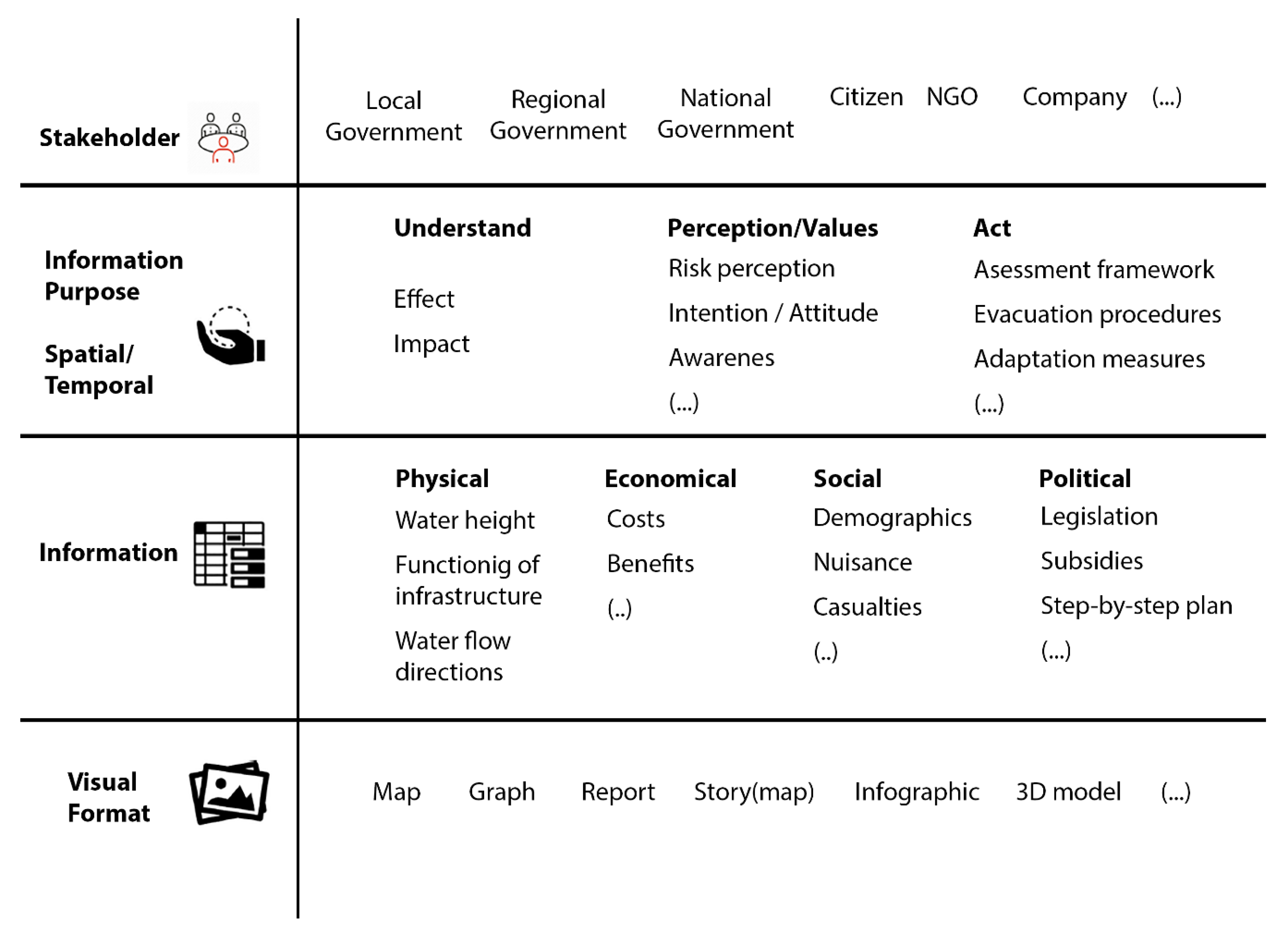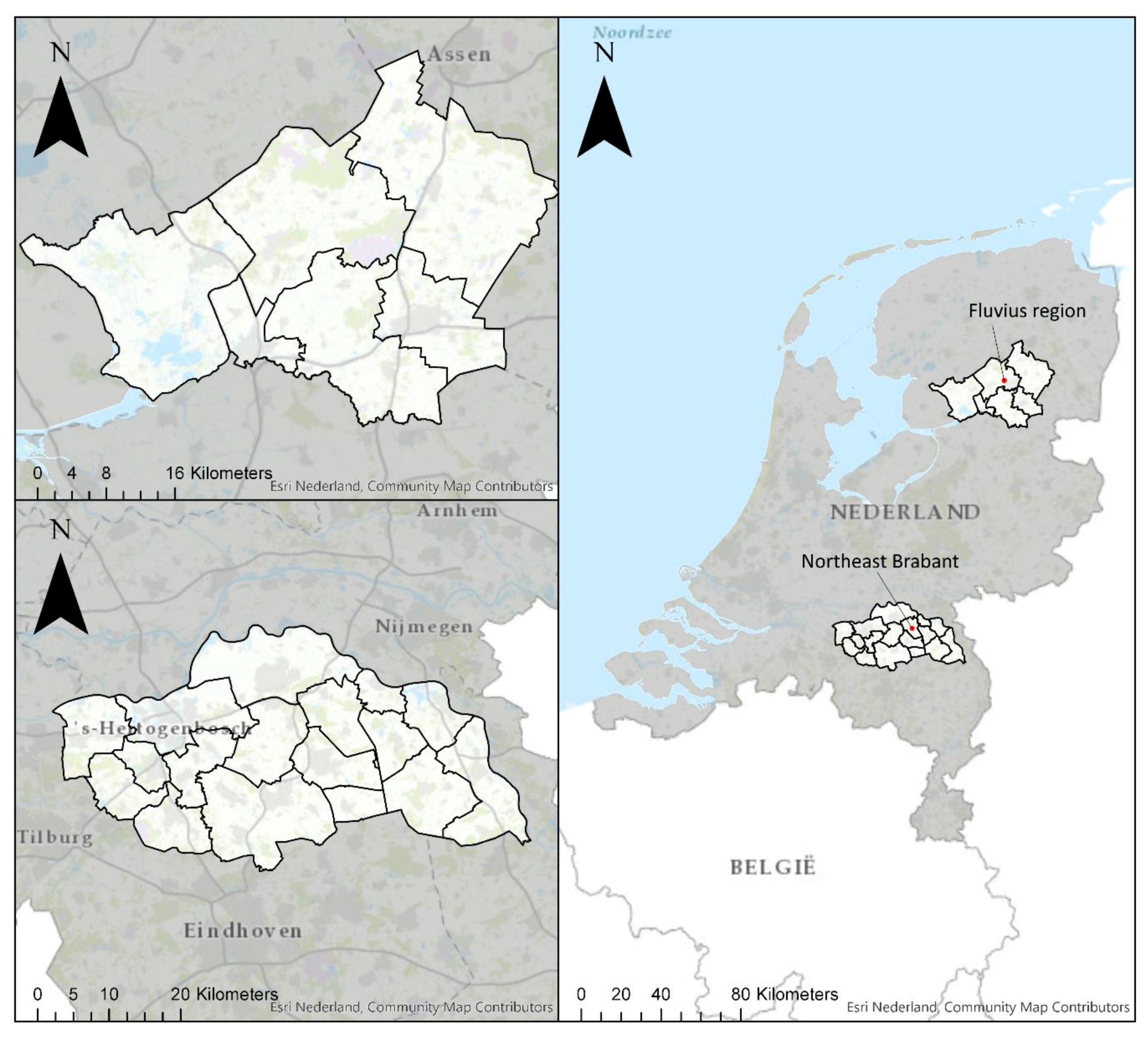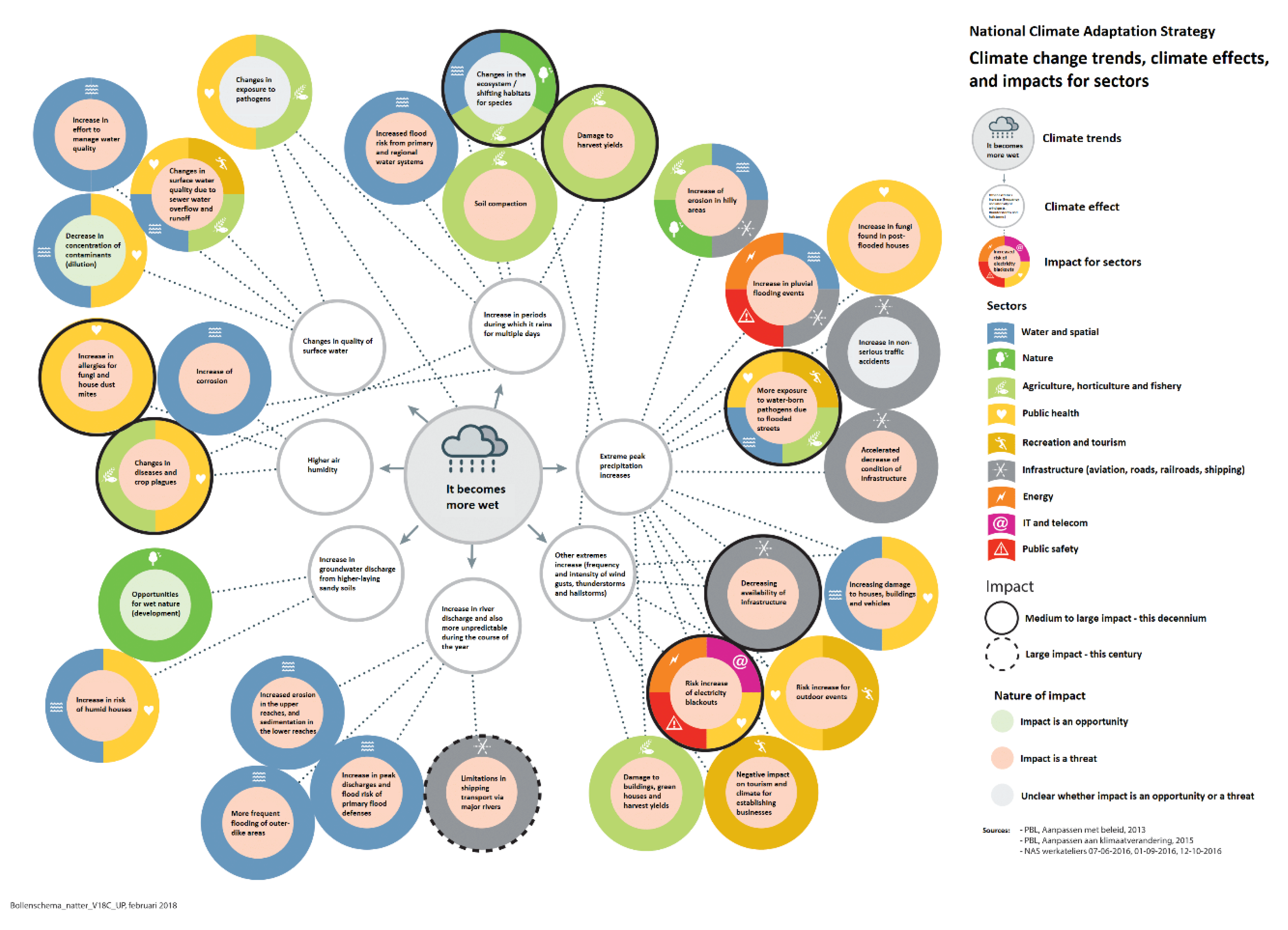Mind the Gap: Towards a Typology of Climate Service Usability Gaps
Abstract
1. Introduction
2. A Template of Climate Information Design
2.1. Climate Change Communication
2.2. Analytical Framework
3. Materials and Methods
3.1. Case Study Policy Context
3.2. Case Study Locations and Climate Services
3.2.1. Northeast of the Province of North Brabant, The Netherlands
3.2.2. FLUVIUS Work Region, The Netherlands
3.3. Data Collection: Documentation, Semi-structured Interviews, and Focus Group Meetings
3.4. Data Analysis
4. Results
4.1. ‘Reading’ the Climate Services
4.2. Illustrating the Usability Gaps
4.2.1. Stakeholder
4.2.2. Purpose
4.2.3. Information
4.2.4. Visual Format
4.3. Counting the Usability Gaps
5. Discussion
6. Concluding Remarks
Author Contributions
Funding
Acknowledgments
Conflicts of Interest
References
- EEA/JRC/WHO. Impacts of Europe’s Changing Climate – 2008 Indicator-based Assessment; EEA: Copenhagen, Denmark, 2008. [Google Scholar]
- EEA. Climate Change Impacts and Adaptation. Available online: https://www.eea.europa.eu/soer-2015/europe/climate-change-impacts-and-adaptation#tab-based-on-data (accessed on 19 December 2019).
- Goosen, H.; de Groot-Reichwein, M.A.M.; Masselink, L.; Koekoek, A.; Swart, R.; Bessembinder, J.; Witte, J.M.P.; Stuyt, L.; Blom-Zandstra, G.; Immerzeel, W. Climate Adaptation Services for the Netherlands: An operational approach to support spatial adaptation planning. Reg. Environ. Chang. 2014, 14, 1035–1048. [Google Scholar] [CrossRef]
- Dutton, J.A. Opportunities and priorities in a new era for weather and climate services. Am. Meteorol. Soc. 2002, 83, 1303–1312. [Google Scholar] [CrossRef]
- Visbeck, M. From climate assessment to climate services. Nat. Geosci. 2007, 1, 2. [Google Scholar] [CrossRef]
- Hulme, M. Why We Disagree about Climate Change: Understanding Controversy, Inaction and Opportunity, 1st ed.; Cambridge University: Cambridge, UK, 2009; ISBN 9781107264168. [Google Scholar]
- Street, R.; Parry, M.; Scott, J.; Jacob, D.; Runge, T. A European Research and Innovation Roadmap for Climate Serivces; European Commission: Luxembourg, 2015. [Google Scholar]
- National Research Council. A Climate Services Vision: First Steps Toward the Future; National Academies Press: Washington, DC, USA, 2001. [Google Scholar]
- Hewitt, C.; Mason, S.; Walland, D. The Global Framework for Climate Services. Nat. Clim. Chang. 2012, 2, 831–832. [Google Scholar] [CrossRef]
- Joint Programme Initiative Workshop. Demand Driven Climate Services in Europe, 11–12 June 2015, Brussels. Available online: http://www.jpi-climate.eu/workshopdemanddrivenclimateservicesinEurope2015 (accessed on 6 March 2018).
- WMO. What are Climate Services? Available online: http://www.climate-services.org/about-us/what-are-climate-services/ (accessed on 8 March 2018).
- Brasseur, G.P.; Gallardo, L. Climate services: Lessons learned and future prospects. Earth’s Futur. 2016, 4, 79–89. [Google Scholar] [CrossRef]
- Medri, S.; Banos de Guisasola, E.; Gualdi, S. Overview of the Main International Climate Services. (1 June 2012). CMCC Research Paper No. 134. Available online: https://ssrn.com/abstract=2194841 (accessed on 17 February 2020).
- Hamaker, R.; Jiménez-Alonso, E.; Rycerz, A.; Baglee, A.; Stegmaier, P. Analysis of Existing Data Infrastructures For Climate Services. Available online: http://eu-macs.eu/wp-content/uploads/2017/07/EUMACS-D13_EXISTING-DATA-INFRASTRUCTURE-FOR-CLIMATE-SERVICES.pdf (accessed on 14 May 2019).
- European Environment Agency. The Adaptation Support Tool. Available online: http://climate-adapt.eea.europa.eu/knowledge/tools/adaptation-support-tool (accessed on 10 December 2019).
- Lemos, M.C.; Kirchhoff, C.J.; Ramprasad, V. Narrowing the climate information usability gap. Nat. Clim. Chang. 2012, 2, 789. [Google Scholar] [CrossRef]
- Weaver, C.P.; Lempert, R.J.; Brown, C.; Hall, J.A.; Revell, D.; Sarewitz, D. Improving the contribution of climate model information to decision making: the value and demands of robust decision frameworks. WIREs Clim. Chang. 2013, 4, 39–60. [Google Scholar] [CrossRef]
- Harrison, M.; Williams, J.B. Communicating Seasonal Forecasts. In Seasonal Climate: Forecasting and Managing Risk; Troccoli, A., Harrison, M., Anderson, D.L.T., Mason, S.J., Eds.; Springer Netherlands: Dordrecht, The Netherlands, 2008; pp. 293–313. [Google Scholar]
- Wilson, E. Adapting to Climate Change at the Local Level: The Spatial Planning Response. Local Environ. 2006, 11, 609–625. [Google Scholar] [CrossRef]
- Moser, S.C.; Ekstrom, J.A. A framework to diagnose barriers to climate change adaptation. Proc. Natl. Acad. Sci. USA 2010, 107, 22026–22031. [Google Scholar] [CrossRef]
- Howlett, M.; Ramesh, M.; Perl, A. Studying Public Policy: Policy Cycles & Policy Subsystems, 3rd ed.; Oxford University Press: Toronto, ON, Canada, 2009; ISBN 9780195428025. [Google Scholar]
- Wu, X.; Ramesh, M.; Howlett, M.; Fritzen, S. The Public Policy Primer; Routledge: London, UK, 2011. [Google Scholar]
- Bowyer, P.; Bender, S.; Rechid, D.; Schaller, M. Adapting to Climate Change: Methods and Tools for Climate Risk Management; Climate Service Center: Hamburg, Germany, 2014. [Google Scholar]
- McColl, L.; Palin, E.J.; Thornton, H.E.; Sexton, D.M.H.; Betts, R.; Mylne, K. Assessing the potential impact of climate change on the UK’s electricity network. Clim. Chang. 2012, 115, 821–835. [Google Scholar] [CrossRef]
- Van de Ven, F.H.M.; Snep, R.P.H.; Koole, S.; Brolsma, R.; van der Brugge, R.; Spijker, J.; Vergroesen, T. Adaptation Planning Support Toolbox: Measurable performance information based tools for co-creation of resilient, ecosystem-based urban plans with urban designers, decision-makers and stakeholders. Environ. Sci. Policy 2016, 66, 427–436. [Google Scholar] [CrossRef]
- Masson, V.; Marchadier, C.; Adolphe, L.; Aguejdad, R.; Avner, P.; Bonhomme, M.; Bretagne, G.; Briottet, X.; Bueno, B.; de Munck, C.; et al. Adapting cities to climate change: A systemic modelling approach. Urban Clim. 2014, 10, 407–429. [Google Scholar] [CrossRef]
- Koers, G.J. Climate Information: A Potential Stepping Stone towards Enhancing Urban Pluvial Flood Resilience? University of Groningen: Groningen, The Netherlands, 2019. [Google Scholar]
- Moser, S.C. Communicating climate change: history, challenges, process and future directions. Wiley Interdiscip. Rev. Clim. Chang. 2010, 1, 31–53. [Google Scholar] [CrossRef]
- Kirkman, R. A little knowledge of dangerous things: Human vulnerability in a changing climate. In Merleau-Ponty and Environmental Philosophy: Dwellings on the Landscapes of Thought; Cataldi, S.L., Marick, W.S., Eds.; SUNY Press: Albany, NY, USA, 2007; pp. 19–35. [Google Scholar]
- Faber, M.; Manstetten, R.; Proops, J.L.R. Humankind and the Environment: An Anatomy of Surprise and Ignorance. Environ. Values 1992, 1, 217–241. [Google Scholar] [CrossRef]
- Borah, P. Conceptual Issues in Framing Theory: A Systematic Examination of a Decade’s Literature. J. Commun. 2011, 61, 246–263. [Google Scholar] [CrossRef]
- Raaphorst, K.; van der Knaap, W.; Roeleveld, G.; van den Brink, A. Visualization, Participation and Rhetoric: the discursive power of landscape design representations in participatory processes. J. Landsc. Archit. 2019, 14, 42–53. [Google Scholar] [CrossRef]
- Raaphorst, K. Knowing your audience: the contingency of landscape design interpretations. J. Urban Des. 2018, 23, 1–20. [Google Scholar] [CrossRef]
- Latour, B. Visualization and cognition. Knowl. Soc. 1986, 6, 1–40. [Google Scholar]
- Hine, D.W.; Reser, J.P.; Morrison, M.; Phillips, W.J.; Nunn, P.; Cooksey, R. Audience segmentation and climate change communication: conceptual and methodological considerations. WIREs Clim. Chang. 2014, 5, 441–459. [Google Scholar] [CrossRef]
- Raaphorst, K.; Roeleveld, G.; Duchhart, I.; van der Knaap, W.; van den Brink, A. Reading landscape design representations as an interplay of validity, readability, and interactivity: A framework for visual content analysis. Vis. Commun. 2018. [Google Scholar] [CrossRef]
- Yin, R.K. Case Study Research. Design and Methods; SAGE: Los Angeles, CA, USA, 2009. [Google Scholar]
- Meijs, S.; Arbouw, G.; De Graaff, R.; Van Helden-Solleveld, T.; Helmer, M.; Van Hemert, P.; Hoorn, M.; Van Nieuwaal, K.; Schoute, E.; Thijssen, M.; et al. Uitvoeren met ambitie-Uitvoeringsprogramma 2018-2019-Nationale klimaatadaptatiestrategie (NAS); Rijksoverheid: The Hague, The Netherlands, 2018. [Google Scholar]
- Ministerie van Infrastructuur & Milieu. Aanpassen met ambitie-Nationale Klimaatadaptatie-strategie 2016 (NAS); Rijksoverheid: The Hague, The Netherlands, 2016. [Google Scholar]
- Newmark, Z. Normally Wet Netherlands Now Forced to Invest in Fighting Droughts. Available online: https://nltimes.nl/2019/04/05/normally-wet-netherlands-now-forced-invest-fighting-droughts (accessed on 11 December 2019).
- Pieters, J. Netherlands is “Blind to Drought”, Experts Say. Available online: https://nltimes.nl/2018/07/30/netherlands-blind-drought-experts-say (accessed on 11 December 2019).
- De Snoo, E. Bijna Half Miljard Schade Door Regenval en Hagel. Available online: https://www.boerderij.nl/Home/Nieuws/2016/6/Bijna-half-miljard-schade-door-regenval-en-hagel-2824573W/ (accessed on 17 February 2020).
- Koopmans, S.; Ronda, R.; Steeneveld, G.-J.; Holtslag, A.A.M.; Klein Tank, A.M.G. Quantifying the effect of different urban planning strategies on heat stress for current and future climates in the agglomeration of The Hague (The Netherlands). Atmosphere 2018, 9, 353. [Google Scholar] [CrossRef]
- Kumar, R. Research Methodology; SAGE: London, UK, 2014. [Google Scholar]
- Du Perron, E.; van Lamoen, F.; de Vries, B. De NAS-adaptatietool; Provincie Noord-Brabant: s-Hertogenbosch, The Netherlands, 2019. [Google Scholar]
- Kennisportaal Ruimtelijke Adaptatie Bijsluiter gestandaardiseerde stresstest Ruimtelijke Adaptatie. Available online: https://ruimtelijkeadaptatie.nl/stresstest/bijsluiter/ (accessed on 27 January 2020).
- Klimaateffectatlas Over de atlas. Available online: http://www.klimaateffectatlas.nl/nl/over-de-atlas (accessed on 27 January 2020).
- Bryman, A. Social Research Methods; Oxford University Press: Oxford, UK, 2012. [Google Scholar]
- Roosegaarde, D. Waterlicht. Available online: https://www.studioroosegaarde.net/project/waterlicht (accessed on 11 December 2019).
- Mukherjee, U. Climate Adaptation Services and the Factors Influencing Their Usability; Radboud University: Nijmegen, The Nederland, 2019. [Google Scholar]





| Validity | Readability | Interactivity | |
|---|---|---|---|
| Stakeholder | Is the desired action the responsibility of the targeted audience? | Does the visual language, and its possible connotations, match the interpretive frames of the audience? | Is the visual literacy required for interpreting the CS suitable for the target audience? |
| Purpose | Is the purpose (understand, feel, act) suitable for the phase in the policy cycle? | Is the purpose of the CS clear? (otherwise people act before understanding) | Can the CS be repurposed by the user? |
| Information | Is the information shown correct/trustworthy? | Is it clear what information is presented in a CS? | Can the information be modified? |
| Visual format | Does the visual mode enable an accurate representation of the climate phenomenon? | Is the type of mode, and its way of reading, clear? (a story map requires a different viewing than a standard GIS map) | Can aspects of the mode (zoom level, color scheme, etc.) be modified? |
| FLUVIUS Region | Date of Interview | Northeast Brabant | Date of Interview |
|---|---|---|---|
| Nature interest organization; NGO | 2018-10-30 | Agricultural interest organization; NGO | 2019-10-14 |
| Agricultural interest organization; NGO | 2018-11-29 | Local health organization; public | 2019-10-14 |
| Drinking water company; semi-public | 2018-12-04 | Nature interest organization; NGO | 2019-10-16 |
| Safety region; public | 2018-12-13 | Housing corporation: private | 2019-11-05 |
| Local health organization; public | 2019-01-21 | Safety region Northeast Brabant; public | 2019-11-06 |
| Housing corporation; private | 2019-02-05 |
| Drought | Precipitation | Heat | Sea Level Rise | |
|---|---|---|---|---|
| Stakeholder | Local government; Regional government. | Local government; Regional government. | Local government; Regional government. | Local government; Regional government. |
| Purpose | Understand | Understand | Understand | Understand |
| Information | Effect and impact of thematic trend; specified to specific sectors; nature of consequences; temporal scale; Scale analysis: which problems occur at the local or regional scale? - Lower humidity. - Soil drought. - Quality of surface water. - Increase in frequency of extreme drought. - Decrease in river discharge capacity. | Effect and impact of thematic trend; specified to specific sectors; nature of consequences; temporal scale; Scale analysis: which problems occur at the local or regional scale? - Change in surface water quality due to runoff. - Increase runoff from higher sandy soils. - Increase river discharge, more fluctuation. - Increase of extreme weather (wind gusts, lightning strikes, hail). - Increase extreme peak discharge. | Effect and impact of thematic trend; specified to specific sectors; nature of consequences; temporal scale; Scale analysis: which problems occur at the local or regional scale? - Early start of and longer lasting growing season. - Geographic shift of climatic zones. - Increasing periods of extreme high temperatures. - Mild winters. - Warm summers. - High temperature of surface waters, bigger quality issues. | Effect and impact of thematic trend; specified to specific sectors; nature of consequences; temporal scale; Scale analysis: which problems occur at the local or regional scale? - Higher water levels. |
| Visual format | Infographic | Infographic | Infographic | Infographic |
| Drought | Precipitation | Heat | |
|---|---|---|---|
| Stakeholder | Local government, Regional government, agricultural businesses, citizens. | Local government, Regional government, agricultural businesses, citizens. | Local government, Regional government, citizens, public health organization. |
| Purpose | Understand; Act | Understand; Act | Understand; Act |
| Information | Effect and impact of thematic trend, information about:—Max total potential rain shortage in millimeters, now and in 2050. - Explanations for the increase of the frequency and intensity of extreme dry weather. - Drought sensitivity of different land use types in relation to the increasing occurrence of low ground water levels in 2050. - Examples of forest fires in North Brabant as a result of drought, coupled with a fire sensitivity index of natural areas. - Water seepage and filtration. | Effect and impact of thematic trend, information about: - Amount of precipitation during an iconic rainstorm on July 28, 2014. - Explanations for the increase of the frequency and intensity of precipitation. - The damage impact of hail storms, and an explanation that the frequency and intensity of hail storms will increase. - Expected number of ‘very wet’ days (>25 mm precipitation/day) per year now, and in, and in 2050. - Percentage of built up area per neighborhood. - External links to websites regarding concrete interventions taken to limit damage due to water nuisance. | Effect and impact of thematic trend, information about: - Amount of ‘tropical’ days now and in 2050 (max temp > 30 degrees centigrade). - Amount of warm nights (min. temp. >20 degrees centigrade) in urbanized areas, now and in 2050. - Cooling effect of water and vegetation.Percentage of ‘green’ area per neighborhood. - External links to websites regarding concrete interventions taken at the individual and urban level. - ‘Heatplan’ information of the RIVM (Netherlands National Institute for Public Health and the Environment) |
| Visual format | Map; Story map; Text; Photographs. | Map; Story map; Infographic; Video; Text; Media news item. | Map; Story map; Infographic; WebLink; Text. |
| Validity | Readability | Interactivity | |
|---|---|---|---|
| Stakeholder | 16 | 9 | 6 |
| Purpose | 36 | 1 | 8 |
| Information | 27 | 4 | 4 |
| Visual format | 1 | 4 | 2 |
| FLUVIUS Region | Date of Focus Group Meeting 1 | Northeast Brabant | Date of Focus Group Meeting 1 |
|---|---|---|---|
| Municipality Hoogeveen/De Wolden | 2018-06-26 | Municipality of Meijerijstad | 2018-11-01 |
| Municipality Midden-Drenthe | Municipality of Boekel | ||
| Municipality Westerveld | Municipality of Uden | ||
| Municipality Steenwijkerland | Municipality of Oss | ||
| Water board Drents Overijsselse Delta | Province of North Brabant | ||
| Province of Drenthe | Water board Aa en Maas | ||
| Province of Overijssel | Royal Haskoning DHV |
© 2020 by the authors. Licensee MDPI, Basel, Switzerland. This article is an open access article distributed under the terms and conditions of the Creative Commons Attribution (CC BY) license (http://creativecommons.org/licenses/by/4.0/).
Share and Cite
Raaphorst, K.; Koers, G.; Ellen, G.J.; Oen, A.; Kalsnes, B.; van Well, L.; Koerth, J.; van der Brugge, R. Mind the Gap: Towards a Typology of Climate Service Usability Gaps. Sustainability 2020, 12, 1512. https://doi.org/10.3390/su12041512
Raaphorst K, Koers G, Ellen GJ, Oen A, Kalsnes B, van Well L, Koerth J, van der Brugge R. Mind the Gap: Towards a Typology of Climate Service Usability Gaps. Sustainability. 2020; 12(4):1512. https://doi.org/10.3390/su12041512
Chicago/Turabian StyleRaaphorst, Kevin, Gerben Koers, Gerald Jan Ellen, Amy Oen, Bjørn Kalsnes, Lisa van Well, Jana Koerth, and Rutger van der Brugge. 2020. "Mind the Gap: Towards a Typology of Climate Service Usability Gaps" Sustainability 12, no. 4: 1512. https://doi.org/10.3390/su12041512
APA StyleRaaphorst, K., Koers, G., Ellen, G. J., Oen, A., Kalsnes, B., van Well, L., Koerth, J., & van der Brugge, R. (2020). Mind the Gap: Towards a Typology of Climate Service Usability Gaps. Sustainability, 12(4), 1512. https://doi.org/10.3390/su12041512






